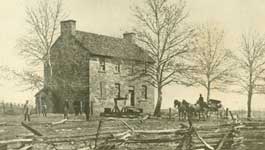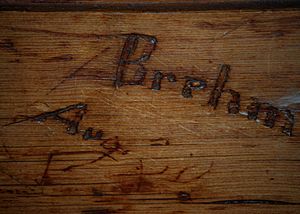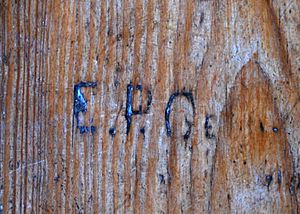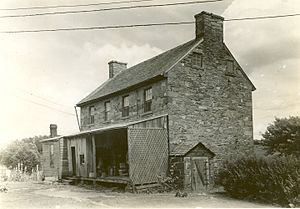The Stone House, Manassas National Battlefield Park facts for kids
Quick facts for kids |
|
|
Stone House, Manassas National Battlefield
|
|
|
U.S. Historic district
Contributing property |
|
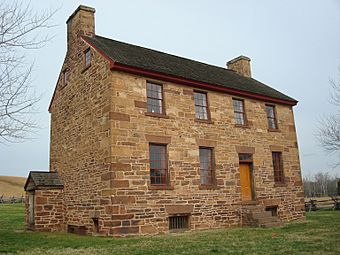 |
|
| Location | Sudley, Virginia |
|---|---|
| Built | c.1828 |
| Part of | Manassas National Battlefield Park (ID66000039) |
The Stone House is a historic building located in Prince William County, Virginia. It is a two-story stone structure. The house was built around 1828 and later updated in 1848. It served as a stop on a busy road called the Fauquier and Alexandria Turnpike.
During the American Civil War, the Stone House played a very important role. It was used as a hospital during both the First and Second Battles of Manassas. Today, the National Park Service owns the Stone House. It is part of the Manassas National Battlefield Park, which is a protected historical site.
Contents
The Stone House: Early History
The land where the Stone House stands was first settled by European families in the late 1700s. A man named Wormeley Carter owned the land in 1801. After he passed away, much of his property was sold.
Building a New Road
In 1808, a company was formed to build a new road. It was called the Fauquier and Alexandria Turnpike. This road was 28 miles long. It connected Fairfax Court House to Fauquier Court House in Virginia. The road was meant to help the town of Alexandria with trade. It would compete with another town called Fredericksburg.
The turnpike had six toll gates, placed about every five miles. Building the road took a long time. It started in 1812 and finished 16 years later.
The First House on the Land
Wormeley Carter's son, Thomas Otway Carter, inherited the Stone House land. In 1828, Thomas Carter sold 148 acres of land. This sale included a house. An 1830 tax record first mentioned a building on the property.
A woman named Mary "Polly" Clark ran a "wagon stand" here. This was like a rest stop for travelers. People stopping at the Stone House had to pay a toll. They could also get food, drinks, and maybe a place to sleep.
A Bigger House is Built
In 1848, Polly Clark's son, Thomas O. Clark, received the Stone House property. Tax records from 1849 show the property's value jumped to $500. This suggests a much larger house was built around that time. So, the Stone House you see today was likely built in 1848.
In 1850, the Clark family sold the Stone House. Henry P. Matthew bought it. He planned to use the land for farming. The road was not as busy as it used to be. The Matthew family lived there for the next ten years.
The Stone House During the Civil War
The Stone House became very important during the American Civil War. It was right in the middle of two major battles.
The First Battle of Manassas (1861)
On July 21, 1861, the First Battle of Manassas took place. Union General Irvin McDowell planned to attack the Confederate army from the side. This plan brought the fighting very close to the Stone House.
Early in the battle, Union soldiers pushed back Confederate forces near the house. The Union troops took control of the Stone House area. But they soon faced heavy fire from Confederate cannons. They were also outnumbered. The Union troops had to retreat from the house. Later, the Stone House came under Union control again.
Between 10 AM and 12 PM, many soldiers fought near the Stone House. Ten Union groups and six Confederate groups clashed. Over 1,000 men were wounded in just two hours. Even though the battle moved away, the Stone House became a hospital. Its strong stone walls, a well for water, and its location near the main road made it perfect. Wounded soldiers could be taken to hospitals in Washington, D.C.
The house quickly filled with injured soldiers. One Union officer saw the cellar floor covered with men. Colonel John S. Slocum was badly wounded. He was brought to the house for care. After the battle, a surgeon found 21 wounded Union soldiers still inside. The next day, the scene was still terrible. Many wounded men had not been treated. Some had even died.
During the battle, the Stone House was constantly under fire. Some cannonballs even hit the house. Two flags were put in the windows to show it was a hospital. But this did not stop the firing. The well outside provided water for soldiers from both sides. As the Union army retreated, the house fell back to Confederate control. It continued to serve as a hospital. Confederates found many wounded Union troops inside. Some were dead, and 36 surrendered as prisoners.
After the fighting ended, the Stone House remained a busy hospital. It was one of the few buildings on a main road. A visitor said the inside was very dirty. Some wounded men were still waiting for help days later. Eventually, the Union wounded were taken to Richmond, Virginia as prisoners. Confederate forces stayed at the house until March 1862.
The Second Battle of Manassas (1862)
In August 1862, the Second Battle of Manassas began. Soldiers marching to the battlefield saw the Stone House. On August 30, Union General John Pope's army was gathered near the house. When the battle started, the Stone House became a hospital again.
As Union troops charged past the house, they found many wounded and dead soldiers. Thirty-six men had hidden behind the strong stone walls. Union doctors marked the building with a flag. They treated the wounded throughout the first day.
On the second day, the Stone House continued as a hospital. Some Union soldiers buried their dead in the yard. Two young soldiers, Charles E. Brehm (age 21) and Eugene P. Geer (age 17), were wounded. They were taken to an upstairs room in the Stone House. While there, they carved their names into the floorboards. Brehm carved "Brehm Aug 30." Geer, unable to finish, carved "E.P. Ge." You can still see these carvings today. Brehm survived the war, but Geer did not live past 1862.
Like the first battle, the Stone House was under Confederate control at the end. But this time, the captured Union soldiers were not taken prisoner. Instead, they were released. Many other Union prisoners from the battlefield were also brought to the Stone House to be released. Five days after the battle, the last ambulance left. The Stone House had seen its last action of the war.
The Stone House After the War
It is not clear when the Matthew family returned home after the Civil War. In 1865, the house and land were sold to Mary Starbuck. After the war, money from road tolls helped maintain the house.
In 1879, the land went to George and Meribah Starbuck. Two years later, Benson Pridemore bought the house. The Pridemores made some changes. They added walls in the upper rooms for their children. This was the first big change to the Stone House. Pridemore also added a front porch, a fence, and a barn.
In 1902, Henry J. Ayres bought the property. In 1904, he added a kitchen and a large back porch. After Ayres passed away in 1912, his son George took over. Pictures show that cannon shells were placed in the outside walls after 1912. These shells likely filled holes from Civil War damage. George Ayres probably put them there.
In 1949, the United States Government bought the Stone House. Since then, it has had two major updates. The roof was replaced, and new electricity and plumbing were added.
The Stone House Today
Today, no one lives in the Stone House. However, it is a popular place for visitors. You can take tours and learn about its history. It is an important part of the Manassas National Battlefield Park.
Images for kids


